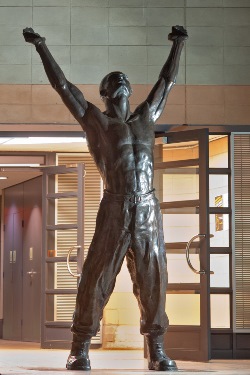120 years of mining engineering
-
Wits owes its existence to mining.
The Wits School of Mining Engineering celebrated its 120th year on 23 March 2017 with a programme organised by Paskalia Neingo (BSc Eng 2010, MSc Eng 2014) and Kelello Chabedi (BSc Eng 1994, MSc Eng 2013).
After a rousing welcome by the Students Mining Engineering Society choir, Vice-Chancellor and Principal Adam Habib opened the event in the Great Hall, pointing out that neither Wits nor Johannesburg would have come into being had it not been for the mining industry. He noted that in 1922, when Wits was established as a university, both the mining industry and miners’ strikes were emerging, and the traditions of industrial leadership and protest have both been associated with Wits ever since.
Looking to the future, Prof Habib said the mining industry needs to transform in a number of respects: demographics; technology; safety; and social inequality. The next 120 years of mining depend on reimagining the partnership of the stakeholders, “so that we are not only successful, but human; not only human, but African”.

Parallel histories
Prof John Cruise (BSc 1967, MSc 1972, PhD 2006) set out the parallel paths of South Africa’s mining, educational and political history, explaining how all local mining engineers came to be “pale males”. The first non-white mining engineer registered at Wits in 1978 and graduated in 1981, and in 1988 the “colour bar” was lifted for both the mining industry and universities in South Africa.
He spoke about even earlier times, such as the arrangements made for returning servicemen to complete their degrees after World War 2 and the 1947 mining tour of the copper belt, when an elephant overturned the Wits group’s vehicle. A special sense of resourcefulness and camaraderie developed among the Wits mining engineers, he said, recalling fun times and also their fund-raising efforts. He was wearing the tie he got for donating R1000 towards building Barnato Hall back when that was a hefty sum for a recent graduate. Then he laid out more special ties on the podium – Cottesloe residence, SAIMM centenary and Wits Mining centenary – and said: “We mining engineers keep our ties.”
Gold Fields looks forward
Prof Fred Cawood (MSc 1997, PhD 2000) introduced the keynote speaker, Gold Fields CEO Nick Holland (BCom 1980, BAcc 1983), as a person with a passion for education and a real interest in students. The company has been a strong supporter of Wits and spends over R33-million annually on skills development and education.
Holland said that Gold Fields has existed longer than the School – 130 years – and its South African gold mine, South Deep, the second-largest in the world, has many more years of operation ahead of it.
Gold is becoming scarce and demand is rising, he said, though there are certainly challenges such as production cost inflation, lower ore grades and the 30% fall in the gold price since 2011.
The company decided in 2013 to focus on mechanised mining, which improves safety and productivity simultaneously. The company does, however, realise that employing fewer people means it will have to find other ways to help communities around mines to develop economically.
“The gold mine of the future has to be set up, structured and managed differently from what it is today, if it is to remain relevant and value-adding to all its stakeholders. This will require a focus on four key areas: operating practices and technology, talent and leadership, partnerships with key stakeholders and industry partners as well as governance,” he said.
Very soon, mining engineers will be people who are skilled in Big Data analysis and systems. Mining exploration and many other operations will be managed remotely.
“While today’s mining CEO manages assets, tomorrow’s leaders will be strategists, focusing on coaching and mentoring, integrated stakeholder management, collaborative decision making and managing a portfolio of mines. Decisions about operations will be devolved down to mine site level. Forging partnerships, with an emphasis on joint ownership, risk management and shared benefits, will be an essential element of the mine of the future.”
Faculty of Engineering Dean Ian Jandrell said that the camaraderie and spirit of the School of Mining Engineering have not changed over the years, but in some ways the future of the profession will be dramatically different. The School is ready to meet the challenge of training a new mining workforce and reskilling the industry’s employees.
WUMEA’s helping hand
Hawk Rakale (BSc Eng 1998) spoke about the efforts of the Witwatersrand University Mining Engineers Association (WUMEA, founded in 1954) to support development at Wits and to help students in financial need. It offers, for example, an interest-free loan to third- and final-year students. This support is a long-standing tradition of the association. Rakale himself was a beneficiary and is now, as founder of Sehwai Exploration Drilling, a proud employer.
Urging the audience to subscribe to WUMEA, he said: “R600 a year, to someone who has the edge from Wits … it’s nothing!”
Head of School Professor Cuthbert Musingwini (MSc Eng 1999, PhD 2010) said he hoped the School would be able to look back and be proud in the year 2136. In the last three years, its research output has risen 180%. “It will be brains and not brawn that takes the industry forward,” he said.
The men who represent the labour force that built mining in South Africa had a place at the event too when Holland was presented with a miniature replica of the Herman Wald statue of the “Unknown Miner”, which stands on West Campus. A reminder of the many people whose lives must be honoured by Witsies of the future.
Did you know?
- in 1896 there were 5 students at the South African School of Mines in Kimberley (from which Wits University eventually developed)
- Wits School of Mining Engineering now has 800 students
- of the undergraduates, 35% are female and 15% international
- 78% of the postgraduates are black
- the first non-white mining engineer graduated in 1981 (Yusuf Sikander Joosub)
- the first black male graduated in 1986 (Modisane Rangwetsi)
- the first female mining engineer graduated in 1994 (Dale Pearson)
- the first black female graduated in 2002 (Celiwe Mosoane)
The Journal of the Southern African Institute of Mining and Metallurgy dedicated two volumes of research papers to the Wits anniversary.


